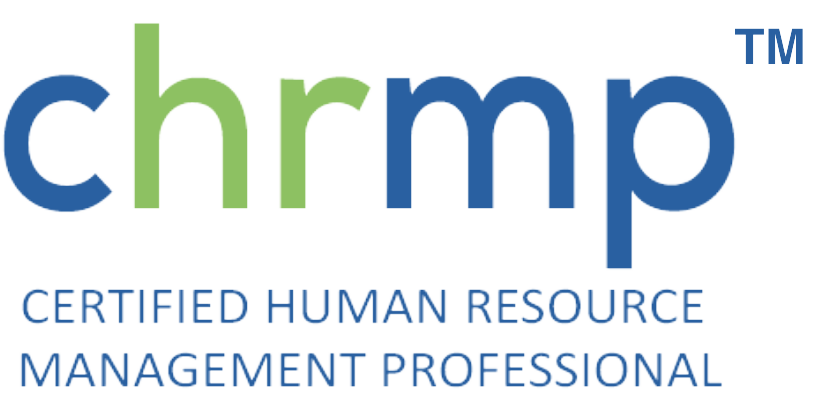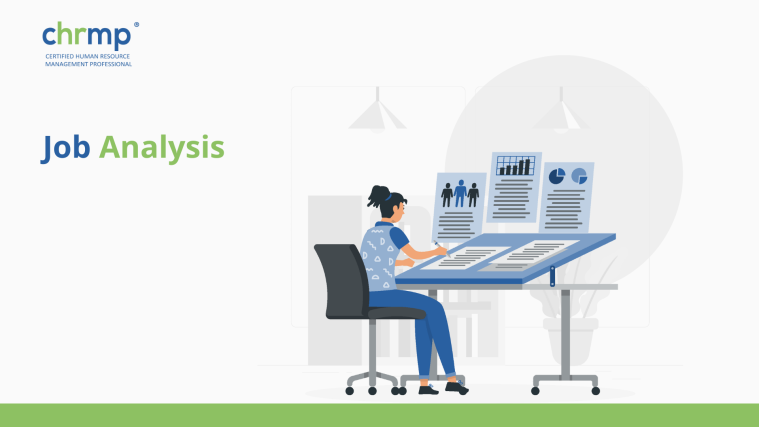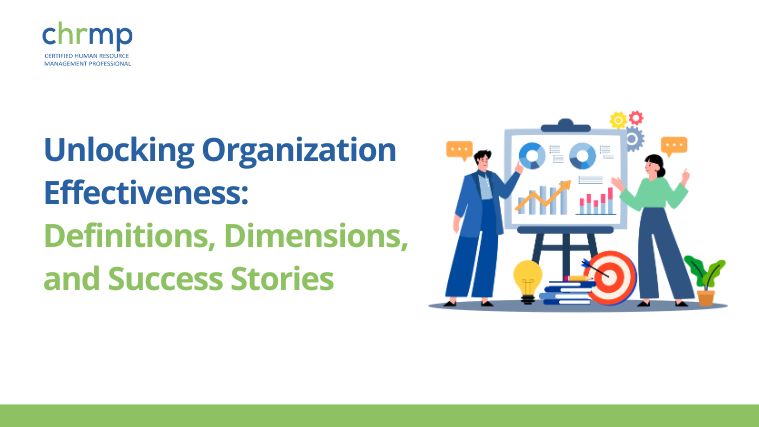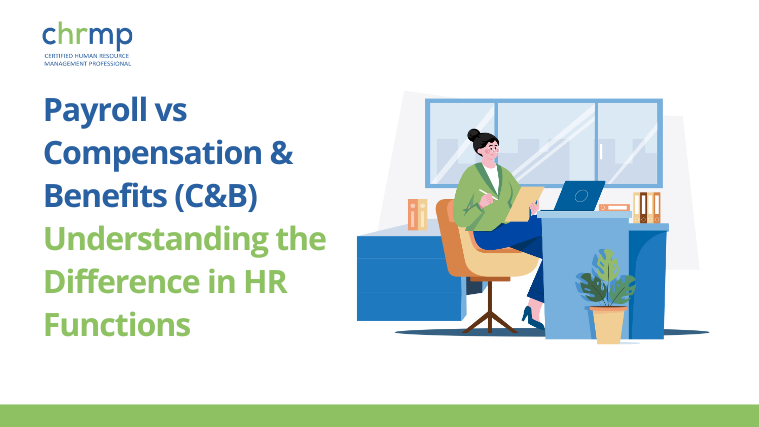If you want to take your organisation to the next level of success, it is vital to have a deep understanding of your workforce and their contribution to the company’s success.
That’s where job analysis comes in! Job analysis is a powerful tool to help us identify the skills and knowledge required for each job in our organisation and ensure that the employees are well-equipped with the necessary tools to succeed.
In this blog, we’ll explore the benefits of job analysis, the different methods for conducting job analysis, and how one can use the results to improve our organisation’s performance.
So buckle up and get ready to take your business to new heights with the power of job analysis!
What is Job Analysis?
Job analysis is the process of gathering and analysing information about the duties, responsibilities, skills, knowledge, professional and academic qualifications and abilities required to perform a particular job efficiently.
It involves studying and documenting a job’s tasks, procedures and outputs, as well as relevant context.
The primary objective of conducting it is to provide a clear understanding of the requirements of a job, including the necessary competencies, qualifications, and characteristics required of a successful job incumbent.
This information is used to develop job descriptions, specifications, and performance standards used in various HR functions, such as recruitment, selection, training, performance appraisal, and compensation.
The various methods used to conduct it are through interviews, questionnaires, observation, and work sample tests.
Then an analysis report is prepared, which consists of the results of the analysis, which in turn outlines the duties, tasks, and responsibilities associated with each job, as well as the knowledge, skills, and abilities required to perform it efficiently.
Defining Job Analysis
Job analysis is a systematic process of gathering and evaluating information about the duties, responsibilities, skills, knowledge, qualifications, and abilities required to perform a specific job effectively. This comprehensive examination involves studying and documenting a job’s tasks, procedures, and outcomes, as well as the relevant context in which the job operates.
Key Components of Job Analysis
- Duties and Responsibilities: Identifying the core tasks and responsibilities that constitute the job.
- Skills and Abilities: Determining the technical and soft skills necessary for successful performance.
- Knowledge Requirements: Outlining the educational background and specialized knowledge needed.
- Qualifications: Specifying the professional certifications and academic degrees required.
- Work Environment: Describing the physical and organizational context in which the job is performed.
A well-conducted job analysis provides two primary outputs:
- Job Description: A detailed account of the tasks, responsibilities, and duties associated with the job.
- Job Specification: The qualifications, skills, knowledge, and attributes required to perform the job effectively.
Applications in HR Functions
The insights gained from job analysis are pivotal for various HR activities, including:
- Job Descriptions: Crafting accurate and comprehensive job descriptions that attract the right candidates.
- Job Specifications: Detailing the specific qualifications and skills required for the role.
- Performance Standards: Setting clear criteria for evaluating employee performance.
- Recruitment and Selection: Streamlining the hiring process by aligning candidate profiles with job requirements.
- Training and Development: Identifying training needs to enhance employee skills and competencies.
- Compensation: Ensuring fair and competitive pay structures based on job responsibilities.
Who Conducts Job Analysis
Job analysis is a collaborative process that involves various stakeholders within an organization to ensure a comprehensive and accurate understanding of each role. Here are the key players typically involved:
1. Human Resources (HR) Professionals
HR analysts and specialists lead the job analysis process, designing and implementing data collection strategies. HR managers oversee the process, ensuring alignment with the organization’s strategic goals and integrating findings into broader HR functions like recruitment and performance management.
2. Department Managers and Supervisors
Managers and supervisors provide essential insights into the daily responsibilities and challenges of the job. Their hands-on experience ensures that the job analysis accurately reflects the practical aspects of the role.
3. Employees (Job Incumbents)
Current employees offer firsthand knowledge about the tasks, required skills, and work environment. Their input is crucial for capturing the nuances of the job that may not be visible to managers or HR professionals.
4. External Consultants
Organizations may engage external HR consultants or industry experts to bring specialized knowledge and an objective perspective. Consultants can streamline the job analysis process and incorporate industry best practices, especially in complex or highly specialized roles.
5. Cross-Functional Teams
Collaboration across different departments, such as IT, Operations, and Finance, ensures that all aspects of the job are considered. This multidisciplinary approach helps in understanding technical requirements, financial implications, and other departmental needs.
Why Job Analysis Matters Today
In today’s dynamic and ever-evolving workplace, the importance of job analysis has surged, becoming more critical than ever before. As organizations navigate through rapid technological advancements, shifting workforce demographics, and changing business landscapes, job analysis serves as a vital tool to ensure that roles are well-defined, relevant, and aligned with both organizational goals and employee needs.
Here’s an in-depth look at why job analysis is indispensable in the contemporary work environment:
1. Adapting to Remote and Hybrid Work Models
The shift towards remote and hybrid work arrangements has redefined job roles and expectations. Job analysis helps organizations understand the specific requirements of these new work models by identifying necessary skills such as self-motivation, virtual communication, and time management. By clearly defining these competencies, companies can tailor their recruitment, training, and performance evaluation processes to support remote employees effectively.
Example: A marketing manager transitioning to a remote role may require enhanced digital collaboration tools proficiency and the ability to manage teams across different time zones. Job analysis ensures these needs are accurately captured and addressed.
2. Facilitating Diversity, Equity, and Inclusion (DEI)
Incorporating DEI into job analysis ensures that job descriptions and requirements are free from bias and promote an inclusive workplace. By systematically evaluating job roles, organizations can identify and eliminate discriminatory language, broaden the talent pool, and create opportunities for diverse candidates. This not only fosters a more inclusive culture but also enhances organizational performance by leveraging diverse perspectives.
Example: Revising job descriptions to focus on essential skills and competencies rather than specific degrees can attract a wider range of candidates, promoting diversity within the organization.
3. Navigating Technological Advancements and Automation
As technology continues to advance, job roles are constantly evolving. Job analysis helps organizations stay ahead by identifying the impact of new technologies on existing roles and determining the skills needed to manage and leverage these advancements. This proactive approach ensures that employees are equipped to handle technological changes, thereby maintaining productivity and competitiveness.
Example: In a manufacturing setting, the introduction of automation and robotics requires job analysis to identify new technical skills and training needs for operators and technicians.
4. Enhancing Employee Engagement and Retention
Understanding the intricacies of each job through job analysis allows organizations to create clear career paths and development opportunities. When employees have a clear understanding of their roles and how they contribute to the organization’s goals, they are more likely to feel engaged and motivated. Additionally, accurate job analysis helps in setting realistic performance expectations and providing appropriate support, which can significantly reduce turnover rates.
Example: Providing employees with detailed job descriptions and growth opportunities based on thorough job analysis can increase job satisfaction and loyalty, leading to higher retention rates.
5. Aligning Workforce with Strategic Business Goals
Job analysis ensures that every role within the organization is aligned with its strategic objectives. By clearly defining the duties, responsibilities, and required competencies for each position, organizations can ensure that their workforce is effectively contributing to achieving business goals. This alignment facilitates better decision-making in areas such as workforce planning, talent management, and organizational development.
Example: A company aiming to innovate its product line can use job analysis to identify and recruit roles that support research and development, ensuring that the workforce is aligned with the company’s innovation goals.
Why is Job Analysis Important?
Job analysis is crucial as it helps organisations understand the nature and requirements of each job.
It provides a detailed and objective understanding of the duties, tasks, skills, knowledge, and abilities needed to perform the job successfully by an incumbent.
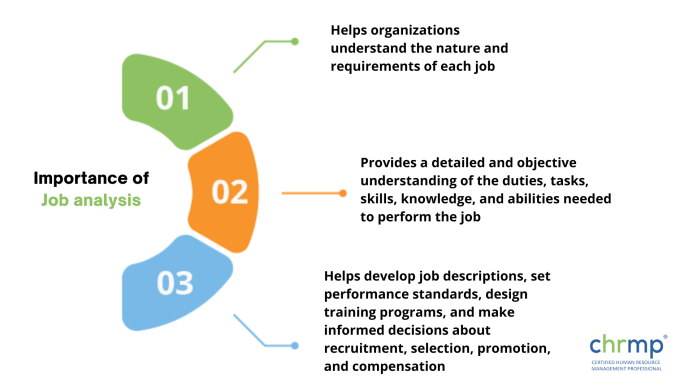
Job analysis plays a pivotal role in effective Human Resources management by providing essential insights that align workforce capabilities with organizational goals. Here are five key reasons why job analysis is crucial:
- Enhances Recruitment and Selection: By clearly defining job duties and requirements, job analysis helps attract and identify the most suitable candidates for each role.
- Facilitates Training and Development: It identifies the specific skills and competencies needed, enabling targeted training programs that support employee growth and performance.
- Supports Performance Management: Establishing clear performance standards and expectations ensures objective evaluations and meaningful feedback for employees.
- Ensures Fair Compensation: Understanding the responsibilities and skills required for each job allows organizations to develop equitable and competitive compensation structures.
Aids in Legal Compliance: Accurate job descriptions help organizations adhere to labor laws and reduce the risk of discrimination claims by ensuring roles are clearly defined and non-biased.
Job Data in Job Analysis
Job data is the critical information gathered during the job analysis process that provides a detailed understanding of a specific role within an organization. It encompasses all the quantitative and qualitative information gathered during the job analysis process. This data forms the backbone of various HR functions, ensuring that decisions related to hiring, training, performance evaluation, and compensation are well-informed and aligned with organizational goals.
Here’s an in-depth look at the key components of job data in job analysis:
1. Job Content
Job content refers to the specific tasks, duties, and responsibilities that make up a job. It outlines what an employee does on a day-to-day basis and the scope of their role within the organization.
Components:
- Tasks: Individual activities performed regularly.
- Responsibilities: Areas of accountability and decision-making authority.
- Work Outputs: Tangible results produced by the job, such as reports, products, or services.
Example: A Content Writer’s job content might include:
- Tasks: Writing blog posts, creating social media content, and editing articles.
- Responsibilities: Ensuring content aligns with brand voice, meeting publication deadlines, and collaborating with the marketing team.
- Work Outputs: Published articles, social media updates, and content calendars.
2. Job Context
Job context encompasses the environmental and organizational factors that influence how a job is performed. It includes the physical, social, and organizational setting in which the job exists.
Components:
- Physical Environment: Location, workspace conditions, and any physical demands of the job.
- Organizational Environment: Company culture, team structure, and reporting relationships.
- Work Conditions: Hours, travel requirements, remote work options, and any special circumstances affecting the job.
Example: For a Field Sales Representative, job context might include:
- Physical Environment: Frequent travel, outdoor meetings, and working in various client locations.
- Organizational Environment: Part of the sales team, reporting to the Sales Manager, and collaborating with the marketing department.
- Work Conditions: Flexible hours, requirement to meet sales targets, and occasional overnight stays.
3. Job Requirements
Job requirements detail the qualifications, skills, knowledge, and attributes necessary for an individual to perform a job successfully. This includes both the minimum and preferred criteria for the role.
Components:
- Educational Qualifications: Degrees, certifications, and formal education needed.
- Skills and Competencies: Technical skills, soft skills, and specific abilities required.
- Experience: Relevant work history and prior experience in similar roles.
- Personal Attributes: Traits such as adaptability, attention to detail, and teamwork.
Example: A Human Resources Manager might have the following job requirements:
- Educational Qualifications: Bachelor’s degree in Human Resources or related field; Master’s preferred.
- Skills and Competencies: Strong interpersonal skills, knowledge of HR software, and expertise in labor laws.
- Experience: Minimum of 5 years in HR roles, with at least 2 years in a managerial position.
- Personal Attributes: Leadership, strategic thinking, and conflict resolution abilities.
The Purpose of a Job Analysis
Job analysis is a vital process in Human Resources management that goes beyond the foundational aspects of recruitment and performance evaluation. It serves multiple strategic functions that contribute to the overall effectiveness and sustainability of an organization. Here are five purposes of conducting a job analysis:
1. Optimize Organizational Structure and Workflow
Job analysis helps organizations identify how different roles fit within the overall structure, highlighting areas where responsibilities may overlap or where there are gaps in the workflow. This understanding allows for the optimization of the organizational hierarchy and the streamlining of processes.
For example,in a manufacturing company, job analysis might reveal that both the production manager and the quality assurance manager are handling similar reporting tasks. By redefining their roles, the company can assign distinct responsibilities, thereby enhancing focus and efficiency in each department.
2. Enhance Workforce Planning and Talent Management
Job analysis provides detailed insights into the current and future needs of the workforce. It assists in identifying the skills and competencies required for various roles, facilitating effective workforce planning and talent management strategies.
For example,a tech company anticipating rapid growth in its software development team can use job analysis to determine the specific technical skills and experience levels needed. This enables targeted recruitment efforts and the development of training programs to build the necessary expertise internally.
3. Support Health, Safety, and Compliance Initiatives
Job analysis plays a critical role in identifying the physical and mental demands of a job, ensuring that workplaces are designed to promote employee health and safety. It also helps organizations comply with occupational health and safety regulations and standards.
For instance, in a construction company, job analysis might reveal that site supervisors are frequently exposed to high-noise environments and heavy lifting tasks. Based on this data, the company can introduce noise-canceling equipment and provide training on proper lifting techniques to enhance safety and reduce the likelihood of injuries.
4. Facilitate Strategic Decision-Making and Organizational Development
Job analysis provides critical data that informs strategic decisions related to organizational development, restructuring, and expansion. It offers insights into how different roles contribute to the organization’s long-term goals and objectives.
For example,a retail chain planning to expand into new markets can use job analysis to determine the specific roles and skills needed in new locations. This ensures that each new store is staffed with employees who possess the necessary competencies to succeed in diverse environments.
5. Promote Organizational Agility and Adaptability
In a rapidly changing business environment, job analysis helps organizations remain agile by regularly updating job roles and requirements to reflect new technologies, market conditions, and business strategies. It ensures that the workforce can adapt to changes effectively.
For instance,a financial services firm implementing new fintech solutions can use job analysis to redefine roles within the IT and customer service departments. This ensures that employees are equipped with the latest technical skills and can effectively support the integration of new technologies.
5 Methods of Conducting a Job Analysis
Several methods can be used to conduct a job analysis, depending on the nature of the job and the information needed.
Here are some of the most commonly used methods:

1. Interviews:
The employees performing the job or their supervisors must be interviewed to gather information about the job’s tasks, skills, responsibilities and outcomes.
2. Observation:
Observation of the job being performed in real-time often provides valuable insights into the tasks, processes, and skills involved and how resources and time can be used judiciously, yet the outcome is perfect.
This method can be useful for jobs that are highly structured and repetitive.
3. Questionnaires:
Distribute standardised questionnaires to employees to gather information about their job duties, skills, and knowledge.
This method can be helpful in gathering data from a large number of employees in a short interval of time.
4. Work Sampling:
Work sampling is an observation of employees performing their job tasks at random intervals throughout the day.
This method can provide a snapshot of the variety and frequency of tasks involved in the job.
5. Critical Incident Technique:
This method involves gathering information about some specific incident that occurred on the job that was critical to its success or failure.
This method can be useful for identifying the specific skills and knowledge needed to handle challenging situations in the workplace.
Each method has advantages and disadvantages, and organisations may choose to use one or more to obtain a comprehensive understanding of the job.
The choice of method will depend on the nature of the job, the resources available, the goals of the job analysis and the organisation as a whole.
Steps to Conduct a Job Analysis
Conducting a thorough job analysis is a systematic process that involves several key steps to ensure that each job within an organization is well-understood and accurately documented. This process not only clarifies job roles but also supports various HR functions such as recruitment, training, performance management, and compensation.
Below are the essential steps to conduct an effective job analysis:
|
Step |
Purpose |
Key Activities |
|
1. Planning the Job Analysis |
Establish a clear plan to ensure the job analysis aligns with organizational goals. |
– Define Objectives: Determine the goals of the job analysis (e.g., updating job descriptions, improving recruitment). – Identify Jobs to Analyze: Select roles based on factors like turnover rates and strategic importance. – Assemble a Job Analysis Team: Form a team of HR professionals, department managers, and possibly external consultants. – Choose Methodologies: Decide on data collection methods such as interviews, surveys, observations, or work samples. |
|
2. Collecting Job Data |
Gather comprehensive and accurate information about each job to build a complete picture of its requirements and responsibilities. |
– Interviews: Conduct discussions with employees and supervisors to gain insights into job duties and required skills. – Questionnaires and Surveys: Distribute structured forms to collect data on job functions and competencies. – Observation: Watch employees perform their tasks to understand workflows and job dynamics. – Work Sample Tests: Have employees perform specific tasks to assess their skills and competencies. – Tools and Resources: Utilize job analysis software and standardized templates for consistent data collection. |
|
3. Analyzing the Data |
Transform raw data into meaningful insights for developing accurate job descriptions and specifications. |
– Data Organization: Categorize data into sections such as duties, responsibilities, skills, and work environment. – Data Interpretation: Identify patterns, common themes, and critical job elements. – Prioritization: Determine the most important job components based on frequency, significance, and impact on organizational goals. |
|
4. Validating the Data |
Ensure the accuracy and reliability of the job analysis by reviewing and confirming findings with relevant stakeholders. |
– Review with Stakeholders: Present findings to job incumbents, supervisors, and other relevant parties for feedback. – Adjustments and Refinements: Make necessary changes based on stakeholder input. – Approval and Finalization: Obtain formal approval from management and key stakeholders to finalize job descriptions and specifications. |
|
5. Developing Job Descriptions and Specifications |
Create clear and comprehensive documents outlining the role’s requirements and expectations. |
– Job Description: • Job Title: Clearly state the position’s title. • Summary: Provide a brief overview of the job’s primary purpose and key responsibilities. • Duties and Responsibilities: List the main tasks and responsibilities. • Work Environment: Describe the physical and organizational context. – Job Specification: • Qualifications: Detail necessary education, certifications, and professional experiences. • Skills and Competencies: Specify required technical and soft skills. • Personal Attributes: Highlight traits that contribute to successful performance. |
|
6. Implementing and Updating the Job Analysis Process |
Integrate job analysis findings into HR practices and maintain their relevance over time. |
– Approval and Finalization: Obtain formal approval from management and key stakeholders to finalize job descriptions and specifications. – Integration into HR Systems: Incorporate job descriptions and specifications into HR information systems and recruitment platforms. – Training HR Staff and Managers: Educate HR professionals and managers on effectively using job analysis data. – Regular Reviews and Updates: Schedule periodic reviews to ensure job analyses remain accurate and relevant, especially after significant organizational changes or technological advancements. |
Some steps involved in conducting a job analysis are:
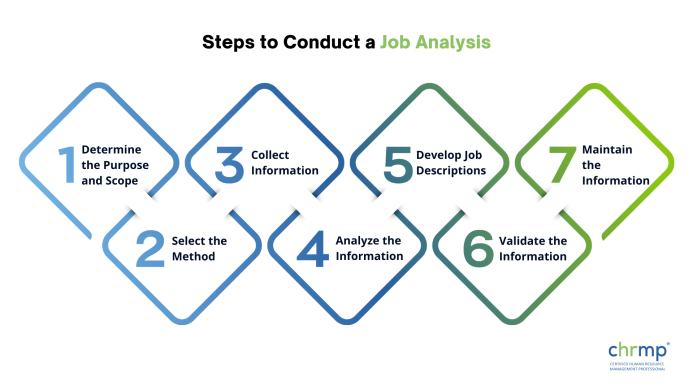
Step 1: Determine the Purpose and Scope: The first step is to determine the purpose and scope of the job to be analysed.
This involves identifying the job or jobs to be analysed, the level of clinical detail required, and the intended use of the information gathered.
Step 2: Select the Method: Selection of the appropriate method or combination of methods to conduct the analysis based on the nature of the job, the information needed, the process and the outcome.
Step 3: Collect Information: The chosen method is then used to collect information about the job.
This could involve interviewing employees and supervisors, observing the job being performed, or distributing questionnaires.
Step 4: Analyse the Information: Then comes the analysis of the information collected to identify the tasks, duties, responsibilities, requirements and outcome of the job.
This may involve breaking down the job into its parts and identifying the knowledge, skills, and abilities required for each component.
Step 5: Develop Job Descriptions: The results of the analysis are then used to develop job descriptions, which outline the tasks, responsibilities, and requirements of the job.
This document can be used for recruitment, training, and performance evaluation.
Step 6: Validate the Information: Once the job description is developed, it should be validated by employees and supervisors to ensure that it accurately reflects the nature and requirements of the job, which the incumbent would have to fulfil through interviews, observation, questionnaires, work sampling, or the critical incident technique.
Step 7: Maintain the Information: Job analysis should be an ongoing process, and the information gathered should be updated regularly to reflect changes in the job or organisation from time to time at regular intervals or whenever a new job is created or significant changes are made to existing ones.
These steps must be followed for organisations to conduct a comprehensive job analysis.
Challenges of Conducting a Job Analysis
Job analysis can be a challenging process due to various factors. Some of the common challenges of job analysis are:

Job analysis can be a challenging process due to various factors. Some of the common challenges of job analysis are:
1. Time-consuming process:
Analysing jobs is a time-consuming process that requires a significant amount of effort and resources to conduct. It involves collecting data, analysing information, and developing job descriptions and specifications.
2. Complex job roles:
The complexity of job roles can make analysing jobs challenging. Some job roles require a diverse range of skills, knowledge, and abilities, making it challenging to capture all aspects of the job in a job analysis.
3. Subjectivity:
Job analysis can be subjective, as it depends on the interpretation and perceptions of the individuals conducting the analysis. People may have different opinions on the same job role, leading to inconsistencies in the process.
4. Lack of participation:
Analysing jobs requires participation from employees, supervisors, and other stakeholders. However, some employees may not be willing to participate, or their participation may be limited, leading to incomplete or inaccurate job analysis results.
5. Changing work dynamics:
Job roles and responsibilities can change due to technological advancements, organisational restructuring, or other factors. This can make analysing jobs challenging, requiring frequent updates and revisions to keep up with the changes.
6. Legal compliance:
Job analysis must comply with legal regulations and guidelines, such as the Americans with Disabilities Act (ADA) and the Fair Labor Standards Act (FLSA). Failure to comply with these regulations can result in legal consequences.
Analysing jobs can be challenging due to their complexity, subjectivity, and various other factors. Overcoming these challenges requires careful planning, effective communication, and a commitment to accuracy and fairness.
Job Analysis vs. Job Description: What’s the Difference?
Job analysis and job description are two distinct but related concepts.
While analysis is the process of gathering and analysing information about a job to identify its duties, responsibilities, and requirements, a job description is a document summarising the information gathered through job analysis.
Here are the main differences between job analysis and job description:
1. Purpose:
The purpose of an analysis is to gather and analyse information about a job to understand its nature and requirements to evaluate performance standards, design appropriate training and development programs and prepare more accurate job descriptions for recruitment purposes and other HR functions, while the purpose of a job description is to summarise the information gathered through analysis in a standardised format.
2. Scope:
A comprehensive study of the job, including its tasks, duties, responsibilities and requirements, has to be done before the analysis. In contrast, a job description is a narrower concept focusing on summarising the information gathered through job analysis in a standardised format.
3. Content:
Job analysis provides a detailed and objective understanding of the job’s nature, requirements and outcomes, while job description provides a summary of the job duties, responsibilities and requirements.
In summary, job analysis is the process of gathering and analysing information about a job to design training programs for recruitment and selection purposes and set performance standards in the company for appropriate dispensation of rewards and promotion. In contrast, a job description is a document summarising the information gathered through job analysis.
Job analysis is a broader concept that comprehensively explains the job. In comparison, a job description is a narrower concept focusing on summarising the information gathered through job analysis.
Conclusion
To conclude, a job analysis is a crucial tool to provide organisations with a detailed understanding of the nature and requirements of a job for developing accurate job descriptions, set performance standards, designing effective training programs, and making informed decisions about recruitment, selection, promotion, and compensation.
Various individuals like HR professionals, managers, supervisors, or subject matter experts can conduct it.
There are several methods that can be used to conduct a job analysis, including interviews, observation, questionnaires, work sampling, and the critical incident technique. The choice of method will depend on the nature of the job and the information needed.
Job analysis has become more critical in today’s rapidly changing business landscape. As jobs evolve and new roles emerge, organisations must continually update their understanding of the job and its requirements.
By making job analysis an ongoing process, organisations can ensure they have the information they need to effectively manage their workforce and take their business goals to higher levels of success.
FAQs
1. What is the purpose of job analysis?
Answer: Job analysis aims to gather and analyse information about a job to understand its nature and requirements. This information is used to develop job descriptions, set performance standards, design training programs, and make informed recruitment, selection, promotion, and compensation decisions.
2. What are the benefits of conducting a job analysis?
Answer: Conducting a job analysis provides several benefits, including a better understanding of the job and its requirements, the ability to develop more accurate job descriptions, improved recruitment and selection processes, better training and development programs, and more effective performance evaluations.
3. Who typically conducts a job analysis?
Answer: A job analysis can be conducted by various individuals within an organisation, including HR professionals, managers, supervisors, or subject matter experts. The choice of who performs the job analysis will depend on the nature of the job and the resources available.
4. What methods can be used to conduct a job analysis?
Answer: Several methods can be used to conduct a job analysis, including interviews, observation, questionnaires, work sampling, and the critical incident technique. The choice of method will depend on the nature of the job and the information needed.
5. How is the information gathered in a job analysis used?
Answer: The information gathered in a job analysis is used to develop job descriptions, set performance standards, design training programs, and make informed decisions about recruitment, selection, promotion, and compensation. It provides an objective and detailed understanding of the job and its requirements, which can inform various HR functions.
6. How often should a job analysis be conducted?
Answer: Job analysis should be an ongoing process, and the information gathered should be updated regularly to reflect changes in the job or organisation. A job analysis may be conducted when a new job is created, when significant changes are made to an existing job, or on a regular schedule, such as every two to three years.
7. What is the meaning of job analysis?
Answer: Job analysis is a systematic process of gathering and evaluating information about the duties, responsibilities, skills, knowledge, qualifications, and abilities required to perform a specific job effectively. This comprehensive examination involves studying and documenting a job’s tasks, procedures, and outcomes, as well as the relevant context in which the job operates.
8. What are the steps in job analysis?
- Planning the Job Analysis: Define objectives, identify roles, assemble a team, and choose data collection methods.
- Collecting Job Data: Use interviews, questionnaires, observation, work sample tests, and tools/resources to gather information.
- Analyzing the Data: Organize, interpret, and prioritize the collected data to extract key job components.
- Validating the Job Analysis Data: Review and refine findings with stakeholders to ensure accuracy before creating job descriptions.
- Developing Job Descriptions and Specifications: Create detailed job descriptions and specifications based on validated data.
- Approving and Implementing the Job Analysis: Finalize job descriptions, integrate them into HR systems, train staff, and regularly update job analyses.
9. What is the Meaning of Work Analysis?
Answer: Work analysis involves thoroughly examining an organization’s work processes and workflows. While job analysis focuses on individual roles, work analysis looks at how various jobs and tasks interact to support the organization’s overall objectives. It aims to evaluate process efficiency, identify areas for improvement, and ensure that work activities align with strategic goals.
10. What is the difference between work and job analysis?
|
Aspect |
Job Analysis |
Work Analysis |
|
Definition |
A systematic process of gathering and evaluating information about the duties, responsibilities, skills, knowledge, qualifications, and abilities required to perform a specific job effectively. |
A comprehensive examination of work processes and workflows within an organization, focusing on how different jobs and tasks interact and contribute to overall objectives. |
|
Focus |
Individual job roles and their specific requirements. |
Organizational work processes and the interaction between various jobs and tasks. |
|
Applications in HR Functions |
– Crafting accurate job descriptions. – Detailing job specifications. – Setting performance standards. – Streamlining recruitment and selection. – Identifying training needs. – Developing fair compensation structures. |
– Optimizing work processes. – Enhancing organizational efficiency. – Improving interdepartmental collaboration. – Aligning work activities with strategic goals. – Allocating resources effectively. – Facilitating organizational development and restructuring. |
|
Conducted By |
– Human Resources (HR) Professionals – Department Managers and Supervisors – Job Incumbents (Employees) – External Consultants – Cross-Functional Teams |
– HR Professionals – Operations Managers – Process Improvement Teams – Department Heads – External Consultants (for specialized process optimization) |
|
Example |
JD of Content Writer Duties include writing blog posts, creating social media content, and editing articles. Requirements include a bachelor’s degree in Marketing, strong communication skills, and attention to detail. |
Manufacturing Workflow Assessing how production managers and quality assurance managers handle reporting tasks to eliminate redundancies and enhance departmental efficiency. |
